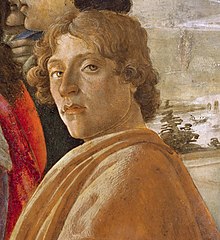
Back Sandro Botticelli Afrikaans Sandro Botticelli AN ساندرو بوتيتشيلي Arabic ساندرو بوتيتشيلى ARZ Sandro Botticelli AST Sandro Bottiçelli Azerbaijani Сандро Боттичелли Bashkir Сандра Бацічэлі Byelorussian Сандра Батычэльлі BE-X-OLD Сандро Ботичели Bulgarian
Sandro Botticelli | |
|---|---|
 Probable self-portrait of Botticelli, in his Adoration of the Magi (1475). | |
| Born | Alessandro di Mariano di Vanni Filipepi c. 1445[1] |
| Died | May 17, 1510 (aged 64–65)[2][3] Florence, Republic of Florence |
| Nationality | Italian |
| Education | Filippo Lippi |
| Known for | Painting |
| Notable work | Primavera The Birth of Venus The Adoration of the Magi Other works |
| Movement | Italian Renaissance |
| Signature | |
 | |

Alessandro di Mariano di Vanni Filipepi (c. 1445[1] – May 17, 1510), better known as Sandro Botticelli (/ˌbɒtɪˈtʃɛli/ BOT-ih-CHEL-ee; Italian: [ˈsandro bottiˈtʃɛlli]) or simply Botticelli, was an Italian painter of the Early Renaissance. Botticelli's posthumous reputation suffered until the late 19th century, when he was rediscovered by the Pre-Raphaelites who stimulated a reappraisal of his work. Since then, his paintings have been seen to represent the linear grace of late Italian Gothic and some Early Renaissance painting, even though they date from the latter half of the Italian Renaissance period.
In addition to the mythological subjects for which he is best known today, Botticelli painted a wide range of religious subjects (including dozens of renditions of the Madonna and Child, many in the round tondo shape) and also some portraits. His best-known works are The Birth of Venus and Primavera, both in the Uffizi in Florence, which holds many of Botticelli's works.[5] Botticelli lived all his life in the same neighbourhood of Florence; his only significant times elsewhere were the months he spent painting in Pisa in 1474 and the Sistine Chapel in Rome in 1481–82.[6]
Only one of Botticelli's paintings, the Mystic Nativity (National Gallery, London) is inscribed with a date (1501), but others can be dated with varying degrees of certainty on the basis of archival records, so the development of his style can be traced with some confidence. He was an independent master for all the 1470s, which saw his reputation soar. The 1480s were his most successful decade, the one in which his large mythological paintings were completed along with many of his most famous Madonnas. By the 1490s, his style became more personal and to some extent mannered. His last works show him moving in a direction opposite to that of Leonardo da Vinci (seven years his junior) and the new generation of painters creating the High Renaissance style, and instead returning to a style that many have described as more Gothic or "archaic".
- ^ a b Ettlingers, 7. Other sources give 1446, 1447 or 1444–45.
- ^ "Sandro Botticelli – Biography and Legacy". theartstory.org.
- ^ Edelstein, Bruce (December 21, 2020). "Botticelli in the Florence of Lorenzo the Magnificent". sothebys.com. Sotheby's.
- ^ Ettlingers, 134; Legouix, 118
- ^ National Gallery of Art (2003). Italian paintings of the fifteenth century. Miklós. Boskovits. Washington: National Gallery of Art. ISBN 0-89468-305-5. OCLC 52687917.
- ^ Ettlingers, 199; Lightbown, 53 on the Pisa work, which does not survive